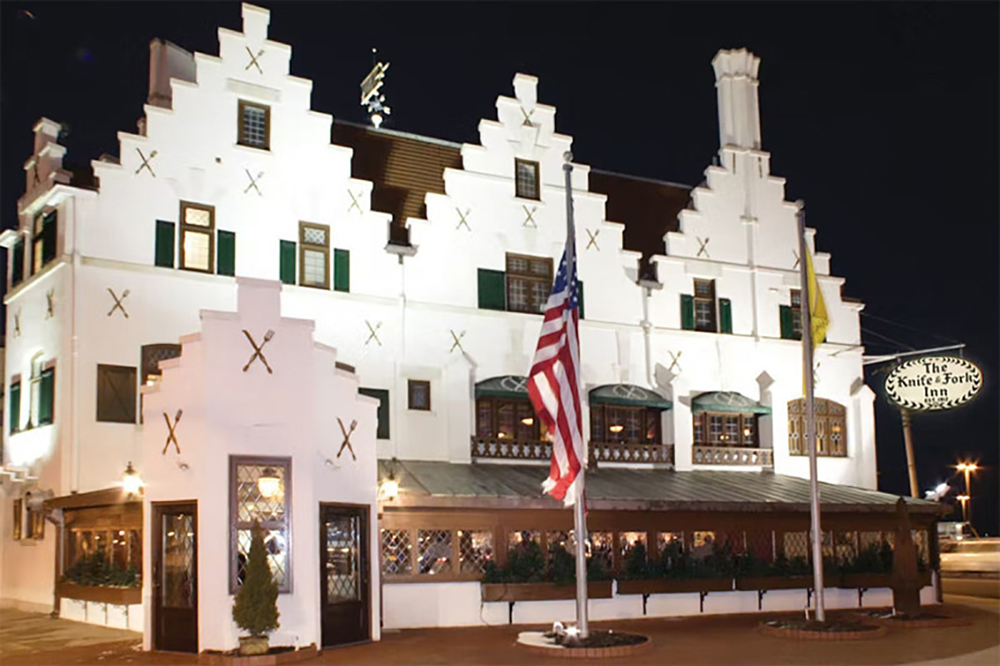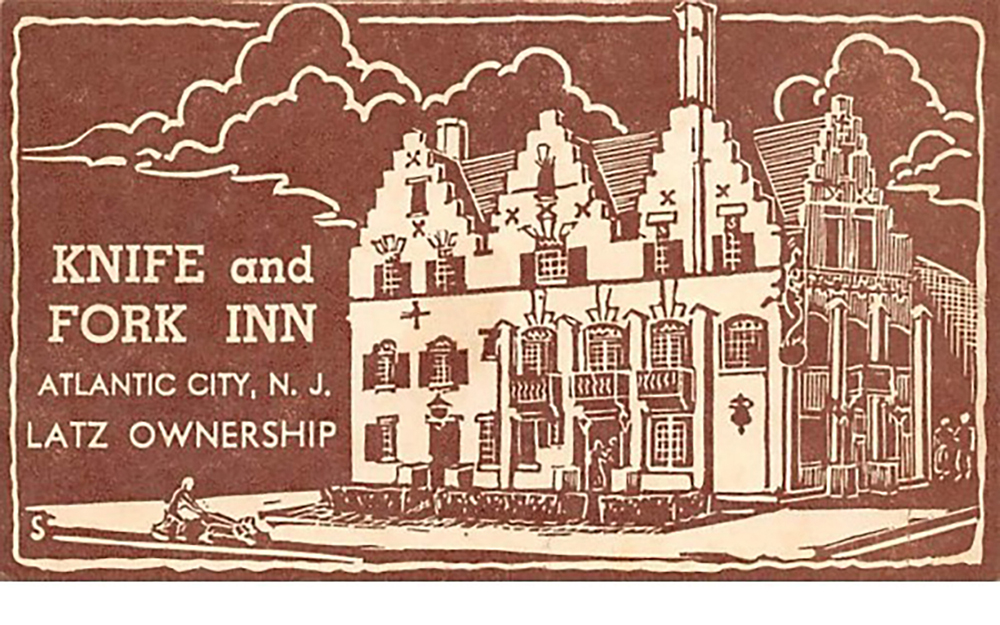By Bruce Klauber
The years 1900 to 1920 were a time of unprecedented growth in Atlantic City. Records show that in 1890, the city’s population was around 13,000. By 1915, the number of residents was close to 52,000. When weekend visitors were factored in, let’s just say that the numbers were incredible.
This growth translated into building more hotels, more homes, more saloons – one estimate read that there were more than 200 bars in Atlantic City by the turn of the century – and of course, more restaurants.
While there’s no official record of how many restaurants were operating in Atlantic City during that period, we know at least two that were open and operating: Dock’s Oyster House, which opened in 1897; and the Knife & Fork Inn, which opened its doors in 1912.
Though it’s hard to believe, both Dock’s and the Knife and Fork are not only still in business, they are thriving and absolutely mobbed – year round, seven days per week.

The Knife & Fork has quite a history. Built by Louis Kuehnle, a powerful politician who owned the Kuehnle Hotel at South Carolina and Pacific avenues, he became such a force in Atlantic City politics that he “took over de facto political control of the city,” according to “Boardwalk Empire” author Nelson Johnson.
With an assist from then-Mayor William Riddle, the Knife & Fork first opened as a drinking club for men only. The first-floor bar was said to be lavishly furnished; the females who accompanied their gentlemen friends waited on the second floor. The third and fourth floors had private rooms of various sizes, which were used for gambling and, shall we say, for other purposes.
The fact that Prohibition became law on Jan. 19, 1919, meant nothing to those who ran the Knife & Fork. The consumption of alcohol did not take place in hidden backrooms; it was all out in the open, which is why the venue was frequently raided by the federal government. By the mid-1920s, the feds had had it. They not only raided the place again, but they destroyed a good portion of the bar and everything in it.
That was the turning point. The club was sold to the Latz Family in 1927, and because the family had no idea when or if Prohibition would ever be repealed, the decision was made to turn the Knife & Fork into a restaurant.
Under the Latz ownership, operation of the Knife & Fork became a family affair. Milton and Evelyn, who lived on the restaurant’s third floor, ran the restaurant until Milton’s passing in 1948. Their sons, Mack and Jim, took over in that year and helped transform the restaurant into not only a tourist destination, but the place to meet, dine and drink for powerful locals and visiting celebrities. Mack and Jim had a parting of the ways around 1985, but the restaurant continued to do great business under Mack’s iron hand.
And an iron hand it was. Mack was a character, and stories about him, on both the local and national levels, are legion. The Los Angeles Times described him as “notoriously cranky” and “known to chew out or eject customers” if he didn’t like their behavior. The Press of Atlantic City deemed him “notoriously gruff.”
I experienced his wrath firsthand in the early 1980s. At that time the Knife & Fork would only take reservations for parties of four and up. The colleagues who took me there for dinner one evening thought they could pull a fast one on Latz by making a reservation for four, when in actuality, we were only a party of three. The plan was to tell the maître d’ that we were waiting for the other party, even though the other party would never show up. It wasn’t long until our table was visited by Mack Latz, who said something like, “I know what you guys are doing. You’re lucky I don’t throw you out.”
By the late 1990s, Latz was closing in on 80 years of age. He decided to retire, but had no luck selling the business. It was a time of transition in Atlantic City and those in the restaurant business were not sure if there was still room for venues like the Knife & Fork Inn, which personified the city’s tradition.
Sadly, it closed for two years. The prevailing belief was that history had passed it by and that it likely would never reopen. Mack’s son, Andrew, didn’t agree, and he reopened it, although he was still looking for a buyer.
In 2005, the Knife & Fork was purchased by the Dougherty Family, owners of Dock’s Oyster House since Dock’s opened its doors 127 years ago. The Doughertys not only refurbished the entire restaurant, they restored its reputation as a landmark.

The key to the inn’s continued success is the careful balance between maintaining tradition, while focusing on the tastes and demands of today’s diners.
Maureen Shay and her husband, Frank Dougherty, are the restaurant’s co-owners. I asked Maureen to clarify the thought process behind the sensitive, “tradition versus today” balancing act.
“In order to stay relevant,” she explained, “you have to keep up not only with what people are eating, but how they are eating, and provide the right ambience to enjoy it in.
“When we first took over the Knife & Fork in 2005, it was in need of repairs and updates both inside and out. It was always our intention to maintain the unique character and history of the building, while installing completely modern systems.
“Certain aspects of the renovation have allowed us to keep pace in the nearly 20 years that followed. The most visible was the construction of a 24-seat bar. We recognized that dining habits were changing and that more people were opting to eat a full dinner at the bar, in addition to just cocktails and appetizers.”
The menu, cocktail and wine lists had to reflect this “contemporary tradition” as well.
“We kept traditional favorites like the lobster thermidor,” says Shay. “But we updated other menu items to reflect growing interest in local sourcing and sustainability. Our craft cocktail list also changes seasonally and reflects growing bespoke cocktail trends. We’ve paired with several liquor brands to create our own blends, with slightly different aging and flavor profiles, and that forms the base of our signature cocktails.”
Alan Richman is an award-winning and notoriously difficult-to-please author and food writer. In a piece written a few seasons ago for Saveur Magazine, Richman simply couldn’t rave enough about the Knife & Fork Inn.
Alan Richman doesn’t gush. This time he did.
“This is one of the loveliest spaces in any American restaurant,” he said. “The modest-sized room is the sort you see in a museum, lifted intact from a palace in Europe and transported whole so visitors can stare at it from behind a velvet rope. The paneling gleams. The stained glass glows at sunset. The ceiling reminds me of Versailles.
“My mother would have loved the Knife & Fork. She would have been dazzled by the dining room and, uncommon for her, would not have said not a negative word about the food. I felt enormously satisfied by the experience, which was everything I dreamed it would be.”
The Knife & Fork Inn may be 112 years old, but the dining experience, in terms of food and service, remains very much today. That’s a challenge, as Maureen Shay explained, but it works. One recent visitor made this comment on Open Table: “As good as it gets!”
For a restaurant that’s 112 years old and counting, that’s pretty good. Here’s to 112 more.
Bruce Klauber is the author of four books, an award-winning music journalist, concert and record producer and publicist, producer of the Warner Brothers and Hudson Music “Jazz Legends” film series, and performs both as a drummer and vocalist.
















